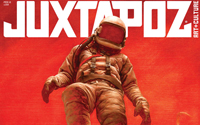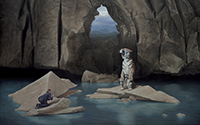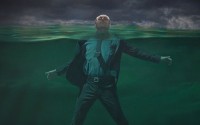BLISS MAGAZINE ISSUE 97
Joel Rea Interviewed by: Jeremy Geddes

Against the backdrop of the visually inspiring nature that surrounds him, Australian artist Joel Rea morphs his meticulously painted images. Self described as a photo-surrealist painter, he places disparate things together and forces them to interact and depict a narrative derived from the artist’s own individual responses to existence. Rea calls on his surrealist practice to muster complexity. His skill is to push, pull and load up the action of his figures within the dramatic and sometimes dangerous landscapes. His painting carries with it a history of collage, of an intellectually satisfying cut-and-paste of images harvested from his photographic excursions, which are then masterfully cemented into paint.

JG: First off, the work is looking stunning, congratulations! How are feeling about your upcoming show with Jonathan LeVine?
JR:The exhaustion I’m feeling due to my usual pre-exhibition art marathon workload is being overpowered by a great sense of excitement and suspense. This will be my first trip to the U.S. and my show with Jonathan LeVine Gallery really feels like the culmination of the last 10 years as a fulltime artist-painter.
How do feel about your last 10 years of painting? I know I can always have mixed emotions about paths I took and retreated from, or choices I backed away from. So thinking about the last 10 years, are there some key moments that you see as defining and have lead to this point?
I love the fact that I can look at my last 10 years worth of paintings and see my life story unfolding; it has been a dream job so far. A real turning point for me was a few years ago was when I acknowledged I could take control of my own publicity and build awareness of my work through a much larger international platform utilizing the Internet and social media. I see my future career now as a global strategy, where as in my early years I was looking for recognition only in very specific, local institutions, resulting in a very narrow path for success. For myself, it’s worked out a lot better going where the love is. Otherwise, you can end up feeling rejected and confused, especially when investing so much of your life force into your art form. Lately the response to my work online is tremendous. There is definitely an audience for what I’m doing all over the world, so now it’s time to take my art to that audience.
I know what you mean. The Internet has been paradigm shifting for the ways artists can build their careers and find their audience. I think particularly for people such as us, being in a fairly geographically isolated location with a small internal market. Having a show with Jonathan is a monumental step out of the bubble of the Australian art world. How did it come about?
Firstly, I became Facebook friends with Jonathan LeVine. I had been following his Gallery for a while and was a fan, so I friend requested him but nothing happened for a while. Then in 2012, I started to think about the prospect of exhibiting my work overseas and how to get around the problem of not wanting to jet-set to all the world’s major art cities and introduce myself to gallery owners one by one. I strategized to hire a filmmaker to produce a quality short video basically introducing viewers to my painting practice, my home and studio life, and my family. Demonstrating the dedication to my work and my stable lifestyle in the video was a plan that paid off – as soon as I posted it online I got a wave of responses immediately. I remember Jonathan LeVine wrote a comment like “great vid,” so I jumped at the chance to start up a dialogue with him and the rest is history.
It sounds like the show has been a long time in the making! The recurring elements in this series of works are very evocative. The tigers and human figures seem to have an emotionally fraught relationship, and both are placed in environments that are actively hostile to their continued existence. They spark off wonderful questions in the mind of the viewer.
Do you have a process for deciding on the elements for a painting and the way in which they are juxtaposed? I know for me it is a very internal process that happens mostly at an unconscious level and so my process is hard to vocalize, but not all painters approach their work in this way. Is this something you are able to articulate?
Usually I have two different approaches, one in which I have an internal vision which I’ll sketch very quickly and then seek out the reference material to fit that idea. The other approach I use references from my photography library to deliberately push an idea out from – this method usually comes from my obsession with a particular image, whether it be a photograph of a tiger, cloud, rock, wave, etc. I don’t go in with any preconditions about the amount of detail I want in a painting, but rather decide the elements based on what best serves the narrative. I attempt to design the most potent combination rather than overkill for detail’s sake. I feel most satisfied when I can simplify an image, boiling it down from all its baggage, resulting in an emblematic visual symbol still containing all life. Sometimes less is more, and other times, like in my latest large scale painting ‘The Promised Land,’ the abundance of characters and elements help me reinforce that particular narrative.
So how did “The Promised Land” come about? What process did you go through when you were planning the painting, and how did the image evolve from conception to the finished piece?
For that painting it started with the reference of the two ice/rock spires. I kept looking at it imagining the characters and scenarios happening all around it. After several drafts, loosely sketching in the elements, I then started pulling in the necessary photographic references and designing the final draft in the computer. Some of the decisions are made up by fate, especially if I can’t totally control the subject I’m photographing, like the tigers or waves for instance. Often, the results from a photo shoot are better than I anticipate and other times I’m unable to capture the vision I have in my mind so I have to work around it. The tigers featured in the painting live about a 30-minute drive from my house at a theme park, the waves are from my local surf break during a huge storm swell and other characters are referenced from a recent trip to a Singapore Zoo with also some shots of myself posing in the backyard. I really enjoy stitching all these random elements together, giving them a new ensemble existence in the form of an artwork. The process takes me back to when I was a young boy and would take several of my action figures outside to pose them in an interesting garden of rock wall setting. I would pose them very carefully creating a diorama-like scene. I believe a lot of my artistic intentions are driven by this internal need to connect with those same pleasures I felt playing as a kid. When I begin the actual painting process I start from the background elements such as the sky, then the rock, working forward to finish with the foreground details.
In relation to the conceptual construction of the painting (understanding which elements to add and which to subtract and how they should be properly juxtaposed), how do you go about that refining process? I find it to be particularly tricky myself, as I can find my internal radar shifting by the day. A specific painting concept will seem perfect one day but will seem glaringly faulty when I come back to it on the next. I find riding these waves and coming to a definite conclusion to be a fraught, lengthy and painful process much of the time. Do you find this, or do have more surety when ironing out the details? And do you find, once you’ve made these decisions, that you continue to agree with them through the painting process, or do you revise whilst you’re painting the work?
When I’m designing the painting in the computer I usually give myself several options to edit down from. Sometimes it can be only a subtle change in a reference, like the position of a character’s finger, but even with such a small detail I give it a lot of consideration. Ultimately I find it best to walk away for a while, come back and then try to make a quick decision based on my impulsive response. When there is a lot of background detail to work though I can often keep the foreground elements optional right up until the day I have to start blocking them in. Once I commit to a detail element and start painting it, I try not to think about the other avenues I could have taken. I always look back at my previous paintings and know I could’ve resolved it better somehow, but I also believe that kind of post-analysis is a necessary condition of artistic progression and growth. I’ve learnt to use those unsatisfied feelings as fuel to improve my future paintings. Luckily for me never being 100% satisfied with my work is a real motivator to keep painting.
As a painter it’s hard not to just focus on the technical side of things and dig into the process… But your work goes well beyond technical realism and explores some evocative themes. How would you describe the work in your coming show? Are there some unifying themes, elements or ideas that you’ve been exploring?
I feel I’ve been making my work in a state of automatic reaction to my life’s journey. Growing up on the Gold Coast in Queensland I spent a lot of time in and around the ocean, but in the last few years a new fear has surrounded what used to be a place of recreation, whether it be of sharks or drowning; water both beautiful and deadly is occurring frequently in my paintings. Dreamlike scenarios of falling or flying are also themes I depict regularly, perhaps linked to my fear of heights or my childhood adoration of flying superheroes. I paint self-portraits in dual identities, where the nostalgic freedom from my youth is opposed with my adult ambitions to succeed. Death is also present in every work I make as a possible outcome or threatening obstacle. Life’s one true promise is death, an inescapable event I obsess over and depict in variety. I’m also thoroughly fascinated by all aspects of nature; it’s pretty much all I’ve painted so far. No hints of technology except the clothes worn by the people depicted in my work and other motifs such as paper. Through nature I understand myself and our world more clearly. The natural world is so endlessly complex and detailed, it really motivates me to make paintings that glorify our natural world, giving it the upmost importance. In explaining my use of other ambiguous subjects like tigers or tsunami waves in my work, I identify with philosopher Arthur Schopenhauer’s concepts of the Sublime. For him, the feeling of the sublime is pleasure in seeing an overpowering or vast malignant object of great magnitude, one that could destroy the observer. Above all, the most dominant theme I see in my own work is duality, both internal and external – a simultaneous adoration of all life whilst also deconstructing its apparent perfection.
It sounds like it will be a wonderful show. They’re themes and ideas that resonate strongly, and I can’t wait to see it hanging at the gallery. How are you feeling about how it all coming together?
I have pushed really hard over the last eight months, so in that regard I’m very satisfied with the work I’ve produced. No matter how long I have to prepare for an exhibition it never feels like enough time, but I can also predict that when the work gets hung on the walls and it’s opening night I’ll feel pretty excited and relieved!
Beasts of Arcadia
New Paintings by Joel Rea
Jonathan LeVine Gallery
New York, NY 10011
529 West 20th Street, 9th Floor
Opening Reception: September 12th 6-8 p.m.
Exhibition runs:
September 12th – October 10th
www.jonathanlevinegallery.com







